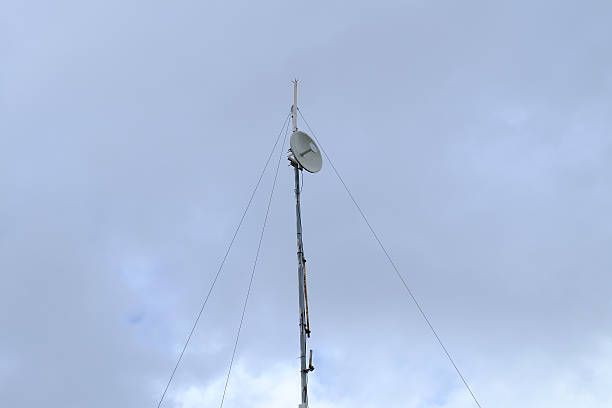
Send Inquiry
What is Dipole Antenna?
Understanding Dipole Antenna Design
Description of Dipole Antenna Structure
At its core, a dipole antenna comprises two identical conductive elements positioned parallel to each other. These elements are often fashioned from metal wires or rods and are separated by an insulator at their center. This arrangement forms the characteristic "dipole" shape, with feeders connecting to each element at the radiating ends.
Components of a Dipole Antenna
In addition to the conductive elements, dipole antennas incorporate feeders and insulators. The feeders facilitate the transmission of radio frequency signals to and from the antenna, while the insulator at the center ensures electrical isolation between the two elements. These components collectively determine the antenna's performance and resonance characteristics.
Calculation of Radiating Element Length and Wavelength
The length of the radiating elements plays a crucial role in dipole antenna design. Typically, this length is approximately half the wavelength of the desired operating frequency in free space. Precise calculations are necessary to ensure optimal performance and resonance, considering factors such as feed impedance and center operating frequency.
Significance of Feed Impedance and Center Operating Frequency
Understanding feed impedance and center operating frequency is essential for fine-tuning dipole antennas. Feed impedance influences the antenna's efficiency and matching with transmission lines, while the center operating frequency dictates the resonant behavior and radiation pattern. Proper adjustment of these parameters ensures optimal antenna performance in practical applications.
By comprehensively grasping the design principles of dipole antennas, engineers and enthusiasts can tailor these antennas to suit specific communication requirements effectively.
Working Principles of Dipole Antenna
Dipole antennas operate on simple yet effective principles that enable the transmission and reception of radio frequency signals.
Transmission Process
In the transmission phase, a dipole antenna receives radio frequency (RF) voltage from a transmitter. This voltage energizes the antenna's conductive elements, causing current to flow. As the current oscillates back and forth along the elements, it generates electromagnetic fields, which in turn propagate outward as radio waves. This process effectively converts electrical energy into electromagnetic radiation for transmission.
Reception Process
Conversely, during reception, the dipole antenna intercepts incoming electromagnetic waves, such as those from distant transmitters. As these waves impinge upon the antenna's conductive elements, they induce oscillating electric currents. These induced currents are then conducted through the antenna's feeders to connected receivers. Subsequently, the receivers extract useful information from the received signals, completing the process of converting electromagnetic waves back into electrical currents for interpretation.
Explanation of Voltage and Current Distribution along the Antenna Length
Throughout both transmission and reception, the voltage and current distribution along the length of the dipole antenna undergo characteristic variations. At the center of the antenna, voltage is typically minimal, while current is maximal, resulting in a high-intensity electromagnetic field. Conversely, at the ends of the antenna, voltage reaches its peak, while current diminishes. This distribution pattern facilitates efficient radiation and reception of radio frequency signals, contributing to the antenna's overall performance.
Exploring Different Types of Dipole Antennas
Dipole antennas manifest in various configurations, each tailored to specific applications and frequency ranges.
Folded Dipole Antenna
Folded dipole antennas feature two dipole elements arranged in parallel and connected at their ends, creating a loop. This design enhances impedance matching and bandwidth capabilities, making folded dipoles suitable for wideband applications such as television broadcasting and amateur radio.
Short Dipole Antenna
Short dipole antennas, as their name suggests, exhibit shorter lengths compared to half-wavelength dipoles. Despite their compact size, short dipoles excel in low-frequency reception, finding utility in applications such as low-frequency receivers and magnetic resonance imaging (MRI) systems.
Half-wave Dipole Antenna (Hertz Antenna)
The half-wave dipole antenna, also known as the Hertz antenna, comprises two quarter-wavelength conductors with a feed point at the center. With a total length equal to half the wavelength of the operating frequency, these antennas offer efficient performance across a broad frequency range, making them ideal for various radio communication applications.
FM Dipole Antenna
FM dipole antennas cater specifically to frequency modulation (FM) broadcasting, offering a cost-effective solution for improved reception of VHF FM signals. Their straightforward design and affordability make them popular choices for both indoor and outdoor FM reception installations.
Fan Dipole Antenna
Fan dipole antennas, characterized by multiple dipole elements arranged in parallel, facilitate multiband operation with a single feed line. Their versatility and ease of design make them suitable for amateur radio enthusiasts seeking to explore different frequency bands without extensive antenna modifications.
Each type of dipole antenna offers unique features, applications, and frequency ranges, catering to diverse communication needs across various industries and user preferences.
Advantages and Disadvantages of Dipole Antennas
Dipole antennas offer a blend of advantages and disadvantages that influence their suitability for different applications.
Advantages
- Simplicity in Design and Installation: Dipole antennas boast straightforward designs, making them easy to construct and install even for beginners. This simplicity reduces costs and time associated with antenna setup.
- Versatility in Configurations: With variations like folded, short, and fan dipole antennas, users can choose configurations that best fit their specific requirements, whether it's wideband reception or multiband operation.
- Omni-directional Signal Reception: Dipole antennas exhibit omnidirectional radiation patterns, allowing them to receive signals from all directions without the need for antenna reorientation.
- Radiation Pattern Characteristics: The radiation patterns of dipole antennas, typically resembling donut shapes, facilitate efficient signal transmission and reception across a wide range of frequencies.
- Flexibility in Reducing Antenna Size with Loading Coils: Loading coils can be incorporated into dipole antennas to reduce their physical size while maintaining resonant characteristics, offering flexibility in antenna placement and integration.
Disadvantages
- Limitations at Low Frequencies: Dipole antennas may not perform optimally at very low frequencies due to their longer physical lengths, which can pose challenges in certain applications such as submarine communication.
- Efficiency Concerns at Certain Frequency Ranges: Efficiency may diminish at specific frequency ranges, affecting overall signal transmission and reception quality, especially in environments with high interference.
- Complexity of Folded Dipole Antennas: Folded dipole antennas, while offering benefits such as improved bandwidth, may introduce complexity in design and implementation, requiring additional expertise and resources.
- Challenges with Bulky Outdoor Antennas: Outdoor dipole antennas, particularly those intended for higher frequencies, may be bulky and cumbersome to install and maintain, posing logistical challenges in deployment.
- Comparison to Typical Antenna Efficiency: While dipole antennas offer simplicity and versatility, they may not match the efficiency and performance of more specialized antenna designs tailored to specific applications.
- Size Limitations of Indoor Dipole Antennas: Indoor dipole antennas are often constrained by size limitations, which can impact their effectiveness, especially in environments with limited space or high signal attenuation.
Applications and Usage Scenarios of Dipole Antennas
Dipole antennas find extensive applications across various industries and scenarios, leveraging their versatility and performance characteristics.
Use in Radio Receivers and TV Broadcasting
Dipole antennas serve as integral components in radio receivers and television broadcasting systems, enabling the reception of broadcast signals with clarity and reliability.
Integration with Simple Antennas for Various Applications
Their simplicity makes dipole antennas ideal for integration with simple antenna systems in diverse applications, including wireless communication networks and amateur radio operations.
Telecommunications and Radio Transmission
In telecommunications and radio transmission, dipole antennas facilitate efficient data transfer and communication over long distances, supporting critical infrastructure and public safety initiatives.
Versatility as Transmitters and Receivers in UHF and VHF Applications
Dipole antennas operate effectively across ultra-high frequency (UHF) and very high frequency (VHF) bands, serving as both transmitters and receivers in applications such as coastal communication and land mobile networks.
Conclusion
As technology continues to advance, there is ample opportunity for further exploration and innovation in the realm of dipole antennas. Engineers and researchers are encouraged to delve deeper into optimizing their design, enhancing their efficiency at lower frequencies, and exploring novel applications in emerging fields such as wireless communication networks and Internet of Things (IoT) devices. By pushing the boundaries of dipole antenna technology, we can unlock new possibilities and propel communication systems into the future.

